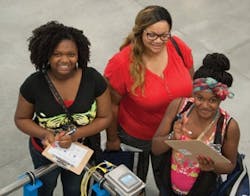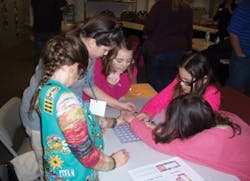Jim Montague is the Executive Editor at Control, Control Design and Industrial Networking magazines. Jim has spent the last 13 years as an editor and brings a wealth of automation and controls knowledge to the position. For the past eight years, Jim worked at Reed Business Information as News Editor for Control Engineering magazine. Jim has a BA in English from Carleton College in Northfield, Minnesota, and lives in Skokie, Illinois.
Check Out Montague's Google+ profile.
Good help is hard to find, but it's much harder if you sit on your hands, and it's easier if you get out and go look for it.For example, many of the oil and gas, petrochemical, chemical and other process companies along the I-55 corridor that runs southwest out of Chicago can't find enough new engineers, technicians and operators to replace their retiring, Baby Boomer veterans. However, some of these experienced engineers, managers and their firms aren't sitting still. Instead, they're taking active roles, not just in recruiting, but also in developing the talent and skills their replacements will require by educating them directly.
"We used to start hiring when existing operators or electricians gained experience and moved up into new positions, but this hasn't been enough," says Kevin Canaday, an analyzer technican at Aux Sable Liquid Products Inc. in Morris, Illinois. "We have about 25% of our staff that could retire now, so we set up an internship program with students from Joliet Junior College, and this past January, we hired one of our former instrumentation and electrical (I&E) interns as a rookie instrumentation mechanic after graduation in December. We still do three years of training after hiring, but JJC gives them a good foundation in the principles we need them to know."
Also Read "What Happened to the E and T in STEM?"
Likewise, Flint Hills Resources in Channahon, Illinois, is facing high numbers of upcoming retirees, but it's responding forcefully, according to Randy Winfrey, FHR's training and procedure coordinator. "We're turning it around by hiring more as others retire, but also by participating in JJC's petrochemical instruction courses," says Winfrey. "We're giving back, but we're also getting back."
Puncturing Prejudices
Clearly, the retirement brain drain is a common and widespread problem for control engineers, system integrators, control and automation suppliers, and their end users and clients in process applications and industries almost everywhere. However, even though everyone talks about the need to replace all the veteran engineers, technicians and operators retiring in the U.S., Europe and elsewhere, it can seem at first like no one's doing anything about developing the next generation of rookies needed to replace them. The usual opinions are that young people only want to be sports and rock stars, they think factories are dirty, and they don't want to take the math and science courses needed to become engineers.
"Mid-skilled engineering technicians are in shortest supply, but it's been hard to get kids interested in these professions. Employers say this interest gap is real, and that it forces production to suffer and prevents their companies from growing," says Chris Paynter, dean of science, technology, engineering and math (STEM) at Central Piedmont Community College in Charlotte, N.C. By combining many of its math, science, engineering and IT sections, the college established its innovative, multidisciplinary STEM operating unit in 2009. Paynter reports a total of 16 Charlotte-area firms run apprenticeships through CPCC, and a new Apprenticeship Charlotte program was started in 2012 to teach U.S. military veterans and other slightly older candidates. "We're really in favor of all the attention STEM has been getting," says Paynter. "It's critical for our region and nation to get these jobs filled, so we can have a diverse and competitive economy."
Luckily, while the Baby Boom brain drain is genuine, the perceived lack of solutions is fiction. There are plenty of high school and college students, recent graduates and mid-career workers looking to switch careers—and all are willing to learn and train. Many community college, university and high school programs are teaching automation and control skills, and many manufacturers conduct apprenticeship and training programs to develop the technical professionals they desperately need. Some colleges and companies are even coordinating their efforts to refine curriculums and focus more effectively on getting the best and most needed skills instilled in students quickly.
To give students technical instruction that has more of a point, STEM programs, such as FIRST Robotics, are multiplying nationwide. This is because STEM gives kids the same sense of purpose and accomplishment that veteran engineers have long reported valuing even more than high salaries.
Return to Class—Employers Too
Of course, the best way for manufacturers and machine builders to secure new engineers and technicians is to work with their local high schools, community colleges and universities. In fact, the missions of many schools explicitly call on them to develop courses that will serve the needs of local businesses.
Also Read "Is STEM Education Gone for Good?"
To tailor its curriculum closer to the skills required by Aux Sable, Flint Hills Resources, Exxon Mobil, Lyondell Bassell and similar firms in its region, JJC developed its Process Control, Instrumentation and Technology (PCIT) program over the past several years. The two-year-degree consists of five primary courses over four semesters, including instruction on Emerson Process Management's DeltaV distributed control system (DCS). These five classes include basic instrumentation, advanced pneumatics, advanced electronics, data acquisition (DAQ) and loop-tuning methods using PID Loop Simulator software from Dex Automation. PCIT also offers a four-month certification program, which includes 273 hours of lab and class time, and teaches 22 sections on operating valves, pumps, boilers and other equipment.
"When we started the PCIT program five years ago, we had one old DeltaV system and added an Amatrol process simulator donated by Wilco," says Greg Pakieser, JJC's technical department chairperson. "However, as PCIT really got moving over the past three years, we now have three DeltaVs and we're seeking a fourth. We also have PC-based DAQ equipment, fieldbus and Profibus networking, and a DCS terminal cabinet with carrier-unit controllers for connecting DCSs to field devices. The cabinet also has five control loops, including two loops that can teach students how to calibrate equipment in the field." As its hardware acquisitions increased, PCIT grew to occupy several labs at JJC, including training spaces for electronics and other courses. Pakieser adds that one of the main reasons JJC's PCIT program has taken off recently is that engineers from local oil and gas and chemical businesses are coming into its classrooms, such as Edward Meyers, who retired from a nearby Citgo facility after 45 years, and taught four PCIT classes before recently passing away. "Ed brought a lot of contacts and equipment to our program, including valves, meters and stroking components," says Pakieser.
Figure 1: Tim Quigley, a second-year Process Control, Instrumentation and Technology (PCIT) student, uses a HART 475 field communicator and its software to monitor, test and control valves in the demonstration lab at Joliet Junior College (JJC). Petrochemical instructor Randy Winfrey and petrochemical program graduate Jason Thibodeaux adjust the clear, distillation training unit at JJC's lab, which gives students direct experience in manipulating distillation processes to produce products.
Tim Quigley, a second-year PCIT student, reports enjoying the range of the program's equipment and the fact that 70% of its classes are hands-on (Figure 1). "We began by programming the old way with hand-pumps and screws, and now we get to use the new toys like the HART 475 field communicator," says Quigley. "We also learned how to use DeltaV manually at first before learning to control it online. At the end of the day, we're just turning equipment on and off, but there are so many fancy ways we can do it. It's cool because we can make giant machines make the proper mixes for the gasoline and different plastics that we all use. We're also using precise amounts of raw materials and precise timing, but how they're applied and build on each other is just incredible, and can be applied in any industry. I also like troubleshooting, such as diagnosing and repairing valves. Also, getting more hands-on experience gets these skills to click much better than learning theories or even seeing videos, and I can go anywhere with what I'm learning."
Saving Know-How with STEM
In a few heads-up cases, the job of rookie engineers is to preserve the knowledge of the more experienced ones, and their insights into the unique operating characteristics of their applications and facilities. Fortunately, their STEM backgrounds, perspective and skills can help in these assignments, too.
For instance, when Bob Vitt began working in 2010 at Phillips 66's Bayway refinery in Linden, N.J., he started as a controls engineer for the crude units and the plant's hydrogen and gasoline reformers, and took over for a colleague who retired in 2011. To maintain balanced performance in the units, he had to quickly gather a lot of information from his predecessor and other coworkers, but this was a challenge because the data was often only in the experts' heads.
Also Read "A Modest Proposal for STEM Education"
"We had guys with up to 45 years of experience, but their knowledge often wasn't written in any documents or drawings," explains Vitt. "If they knew about an instrument or application, we could ask them about it. However, the second after they left, their knowledge left as well. So, our time was limited to get as much of this knowledge transferred as possible, and I and others in our controls group began talking to our veteran people about the special operating characteristics of different units. We hadn't appreciated all the code that had been written behind many units to improve their uptime and availability. Such gems of knowledge were usually found only in handwritten notes or in the memories of the Bayway team."
Vitt reports that he and his team identified and preserved many of these gems, such as the DCS's multiple-input/multiple-output control programs that balance the furnaces serving the process units. "These gems worked well for years, but usually succeeded in isolation," adds Vitt. "Consequently, we also began talking between sections and other refineries to learn which methods were working well or not to provide opportunities to improve our business. Such collaboration and drive to improve exemplify Phillips 66's core values of safety, honor and commitment." After four years, Vitt was appointed as one of Bayway Refinery's large capital projects engineers in December 2013.
There are several main tasks that end users, process control engineers, system integrators and other manufacturers can undertake to develop, recruit and retain new engineers, technicians and operators. Here's a compilation of the most useful steps:
- Seek out and form relationships with local high schools, community colleges, universities and other organizations that can be potential sources of new engineers. technicians and operators. Participate in job fairs and other events.
- Check to see if local courses teach skills that your personnel will require. Advocate for needed changes, help develop new courses, and even offer instructional assistance if needed. (Creating courses to meet the needs of local businesses is one of the main missions of many community colleges.)
- Set up internship and apprenticeship programs that can teach students, graduates and back-to-workers about your company's technological approach and strategies by having them learn and perform basic jobs, and then gauge their employability with increasingly challenging tasks.
- Offer plant tours and open house events for your local community to let parents and their children know what your company does, so they'll begin to think of it as a place where skilled technical jobs might be available to them.
- Ask industry tradeshows to let in more school groups and youngsters, so they can get a taste of all the technologies available.
- Sponsor and mentor local STEM programs, such as FIRST Robotics and other teams.
Though he earned B.S. and MEng degrees in chemical engineering from Cornell University, finishing in 2009, Vitt credits his STEM-related experiences, such as K'nex and Lego Mindstorms in elementary school and PLC-based robotics competitions in high school, with fueling his desire to do something less theoretical and more practical. "I found that I wanted to use chemistry to turn raw materials into something usable and saleable on an industrial scale, and I believe the logic and thinking skills I got from my STEM activities gave me the awareness and ability to do so. Using tools to put different parts together into useful solutions is still what STEM is all about. The only difference is now I'm combining devices to improve systems on an industrial level."
Hands-On Leads to Ah-Ha
Historically, students went to vocational and technical schools for a few years, and then were hired and trained by companies for several more months or years. More recently, many STEM education programs and their industrial partners are trying to compress this process so companies can get trained staff faster.
Back at JJC, Meyers also brought in professional associates like Winfrey, who teaches JJC's four-month petrochemical certification course and its two-day distillation class, which employs a lab with a clear distillation training unit from Bayport Technical in LaPorte, Texas (also Figure 1). "The lab provides a snapshot of a distillation tower's feed tanks, heat exchangers for cooling, bottom products and overhead storage tanks, and shows how different boiling points can produce different products," explains Winfrey. "The first day is theory in the classroom, but the second day is practical, hands-on experience in the lab. This is where our students get those ah-ha moments, when we can see that what we're teaching is really getting across and sinking in."
Besides simply hiring graduates from JJC, Winfrey reports that participating in the petrochemical and PCIT programs gives Flint Hills Resources the added benefit of meeting and working with potential candidates earlier, while taking the classes gives students a better chance of landing an interview and getting hired. "We've really providing for our future here, and the first opportunity is our petrochemical course," says Winfrey. "We show the students the good work they can do, and they can apply as operators and technicians, and then we can hire them."
Beyond aiding rookie-veteran interactions, STEM is also a powerful motivator, according to Adrian Choy, an associate field services engineer at Rockwell Automation, who works onsite with its metalworking clients, most recently on controlling their chemical treating lines. "Because robotics programs like FIRST are a lot more hands-on, when you're designing, testing and building a robot that has your name on it, you have more of a sense of pride," says Choy. "You want to do better, especially when you go to an event, and you're competing in front of a cheering crowd. That's encouragement above and beyond a regular class."
Local, regional and national science, technology, engineering and math (STEM) programs for young people of all ages (and their teachers) are multiplying in number and variety, but many more are needed. Here are some of the most significant U.S. programs:
- Association for Unmanned Vehicle Systems International is a non-profit organization devoted to advancing the unmanned systems and robotics community.
- For Inspiration and Recognition of Science and Technology (FIRST), has four main components: FIRST Robotics Competition for grades 9-12, FIRST Tech Challenge for grades 7-12, FIRST Lego League for grades 4-8, and Junior FIRST Lego League for kindergarten to grade 3. It has 3,500 sponsors and 130,000 volunteers.
- IEEE Robotics and Automation Society strives to advance innovation, education, and fundamental and applied research in robotics and automation.
- Project Lead the Way is a school-based, multi-disciplinary STEM program that stresses collaboration and problem solving, and is used in more than 5,000 U.S. schools.
- Skills USA is a partnership of students, teachers and industry working to make sure the U.S. has a skilled workforce. It's also a member of WorldSkills International.
- SmartAmerica Challenge is a joint effort by industry, academia and government to show how cyber-physical systems (CPS) can create jobs, new business opportunities and socioeconomic benefits.
- UTeach Institute teaches K-12 teachers about STEM topics at 40 universities nationwide.
- VEX Robotics is a design system and robotic kit that introduces middle and high school students to robotics. Vex competitions include more than 4,800 teams from 20 countries playing in over 300 tournaments worldwide.
Figure 2: Students at the new Honeywell Automation College at PetroVietnam University in Hanoi can choose from more than 24 courses and get hands-on training on a variety of Honeywell Process Solutions hardware and software.
Honeywell Process Solutions
In addition, Choy adds that FIRST and other team-based, technical competitions instill essential, non-technical skills early, such as general organization and project management. "You learn real-world judgment as part of a team, so later in your career when a coworker shoots down one of your ideas during the design phase of a project, you've already learned to react better and not take it personally," he explains. "You also learn that people have different styles and attributes, and so you need to find out what those are and how best to interact with them. Without FIRST, I'd have had to get these skills elsewhere, which would've made it more of a struggle to adapt to new fields. With FIRST, I got them ahead of time, which is definitely better because I've used them both in college and at Rockwell Automation."
International Education Efforts
Though most of process control's expertise shortfall is happening in North America, Europe and other developed regions with long operational histories, STEM education and skills are also essential in more recently developing applications and areas.
Just 18 months ago, Honeywell Process Solutions (HPS) partnered with Vietnam National Oil and Gas Group (PetroVietnam) to open a regional, automation-training college in Hanoi to boost the skills of rookie and established process engineers in Vietnam and southeast Asia. Located at the existing PetroVietnam University (PVU), the new Honeywell Automation College offers more than 24 standard and customized courses, and employs a full range of HPS hardware and software, such as Experion Process Knowledge System (PKS) and Safety Manager software (Figure 2).
Figure 3: Brooklyn Sanders (right) and her family, all of Indianapolis, record component readings on Endress+Hauser's Process Training Unit during its Community Career+Education Forum this past June at its new, 80,000-square-foot Customer Center at its headquarters in Greenwood, Indiana.
John Wright, Endress+Hauser
Igniting Kids' Interests
Beyond increasing immediate hiring or training, more process control engineers and other manufacturers are waking up to the need to develop and train potential talent for the longer term. For many, this means cooperating with local high, junior high and elementary schools to offer STEM programs, and sponsoring and mentoring FIRST Robotics and other teams. Also, many manufacturers are conducting tours and open-house events for local kids and parents, just to let their communities know what kind of work their technically specialized neighbors do—and maybe clue in a few youngsters that good-paying jobs are available.
For instance, Endress+Hauser not only opened its new, 80,000-square-foot Customer Center on Sept. 10 at its headquarters in Greenwood, Indiana, but staged its first annual Community Career+Education Forum for students from nine local middle schools and their families in June. They even got to interact with E+H's new process training unit (PTU) and captured process values while it operated (Figure 3).
Figure 4: A team of students and Illinois Girl Scouts, including Megan Sporny of North Aurora, Patty Ortega of Carpentersville, Alexis Kerrins of Aurora, and Joslyn Klitckie and Mary Horn, both of North Aurora, plans and build some basic circuits during the 10th annual Introduce a Girl to Engineering event in March at Siemens Industry's power components plant in West Chicago.
Jim Montague
Similarly, Siemens Industry staged its 10th annual Introduce a Girl to Engineering event for more than 100 girls and their parents this past March at its motor controls and power components manufacturing facility in West Chicago, Illinois (Figure 4). The evening program brought together mostly elementary and middle school girls and their parents for presentations, factory tours, problem-solving challenges and demonstrations by local, competitive robotics team Pwnage and its Frisbee-launching robot. The challenges included seeing who could build the tallest tower using bamboo skewers and marshmallows, and seeing whose paper airplanes could fly the farthest.
Because the event is now in its 10th year, one of its original 15 attendees in 2006, Elizabeth Drennan, returned to encourage her young counterparts. Drennan is now a senior in computer engineering at the University of Illinois at Urbana-Champaign. "Bringing more women into engineering gives our profession and our company a greater diversity of experience and thinking," says Jayne Beck, motor control center and switchboard engineering manager at Siemens West Chicago. "Diversity means people have different ways of approaching problems and challenges, and this brings a lot of value to us and our company."










